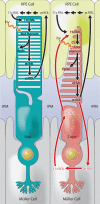Rod and cone visual pigments and phototransduction through pharmacological, genetic, and physiological approaches
- PMID: 22074928
- PMCID: PMC3265844
- DOI: 10.1074/jbc.R111.303008
Rod and cone visual pigments and phototransduction through pharmacological, genetic, and physiological approaches
Abstract
Activation of the visual pigment by light in rod and cone photoreceptors initiates our visual perception. As a result, the signaling properties of visual pigments, consisting of a protein, opsin, and a chromophore, 11-cis-retinal, play a key role in shaping the light responses of photoreceptors. The combination of pharmacological, physiological, and genetic tools has been a powerful approach advancing our understanding of the interactions between opsin and chromophore and how they affect the function of visual pigments. The signaling properties of the visual pigments modulate many aspects of the function of rods and cones, producing their unique physiological properties.
Figures



References
-
- Hargrave P. A. (2001) Invest. Ophthalmol. Vis. Sci. 42, 3–9 - PubMed
-
- Burns M. E., Baylor D. A. (2001) Annu. Rev. Neurosci. 24, 779–805 - PubMed
-
- Arshavsky V. Y., Lamb T. D., Pugh E. N., Jr. (2002) Annu. Rev. Physiol. 64, 153–187 - PubMed
-
- Ebrey T., Koutalos Y. (2001) Prog. Retin. Eye Res. 20, 49–94 - PubMed
Publication types
MeSH terms
Substances
Grants and funding
LinkOut - more resources
Full Text Sources
Other Literature Sources
Research Materials

